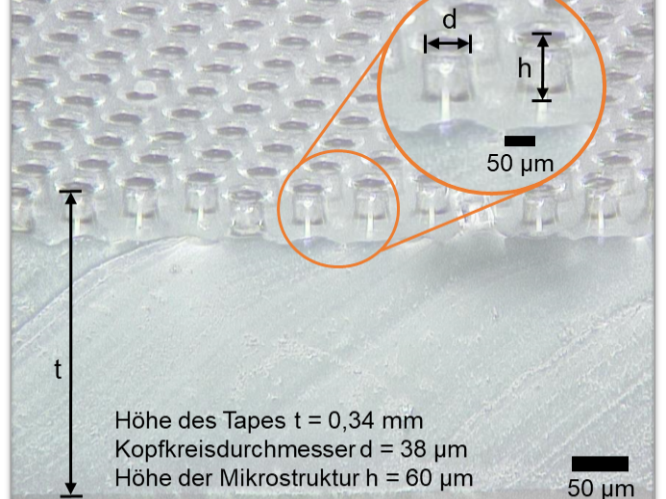Marstape - Low energy handling

On Mars, after the first mission, people will have to rely on the infrastructure brought from Earth. Nevertheless, maintenance and repair is crucial because the Earth-Mars supply chain is complex, slow and difficult, as it will be almost impossible to transport all the materials needed, such as metals. For this reason, resources available on Mars will be used. The "Marstape" project is part of the overall "production with impure materials" project.
In the overall project, (replacement) parts are to be produced by a sintering process with the aid of regolith and then reworked by deep rolling. Handling is carried out as low-energy and autonomously as possible with the aid of dry-adhesive microstructures (Figure 1). The dry-adhesive microstructures are a tape made of polydimethylsiloxane, which adheres to a surface by forming Van der Waals forces with the aid of the microstructure shown in Figure 1.
Figure 1: Representation of the dry-adhesive microstructures and their dimensions recorded with the aid of a laser scanning microscope.
The Bremen Institute for Structural Mechanics and Production Systems at the University of Bremen is developing a handling unit in the project that can be used on Mars. The handling unit can grasp and handle objects autonomously and without damage with the help of dry-adhesive microstructures with a very low energy input. The gripping and handling of the objects is performed by the Van-der-Waals forces built up by the dry-adhesive microstructures.
For the development of this handling unit, the adhesive behavior on different surfaces and materials is first determined. In addition, the determination of the wear and contamination behavior plays a decisive role. When using the microstructures for handling in an autonomous production unit on Mars, replacement due to contamination or wear is difficult to realize. Other aspects to be investigated are possible suitable cleaning procedures as well as the optimization of adhesion with the help of an adaptation layer between the dry-adhesive microstructures and the gripper. In addition, the suitable detachment process for the application scenario on Mars must be investigated in order to finally design and build the gripper for the demonstrator located on Earth.
Contact
Mirja Louisa Krüger, M.Sc.
Tel.: +49 421 218-64830
E-Mail: kruegerprotect me ?!bimeprotect me ?!.de

